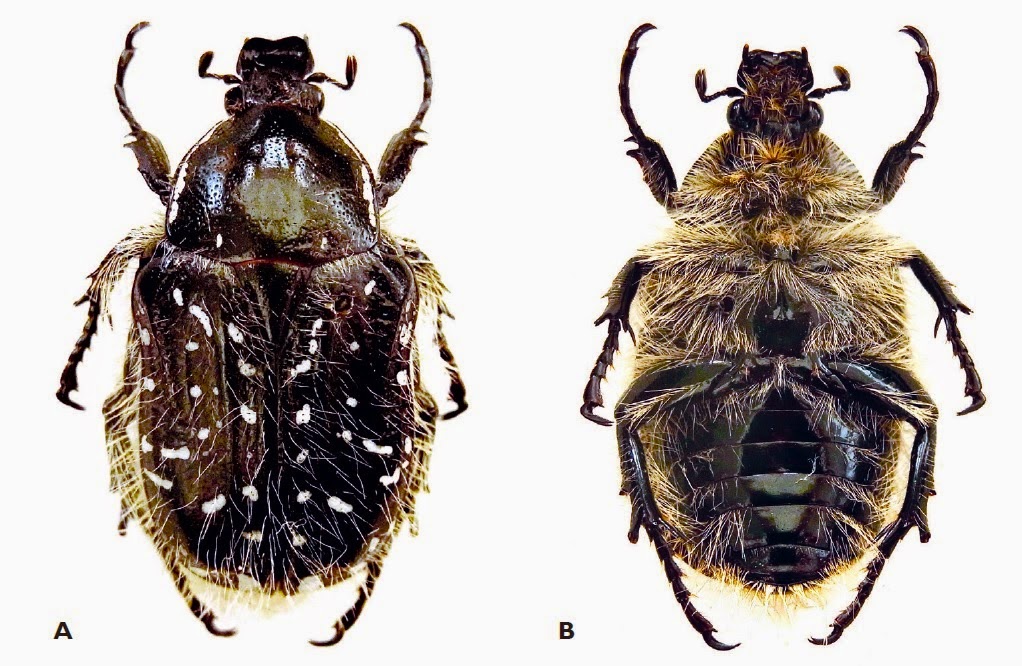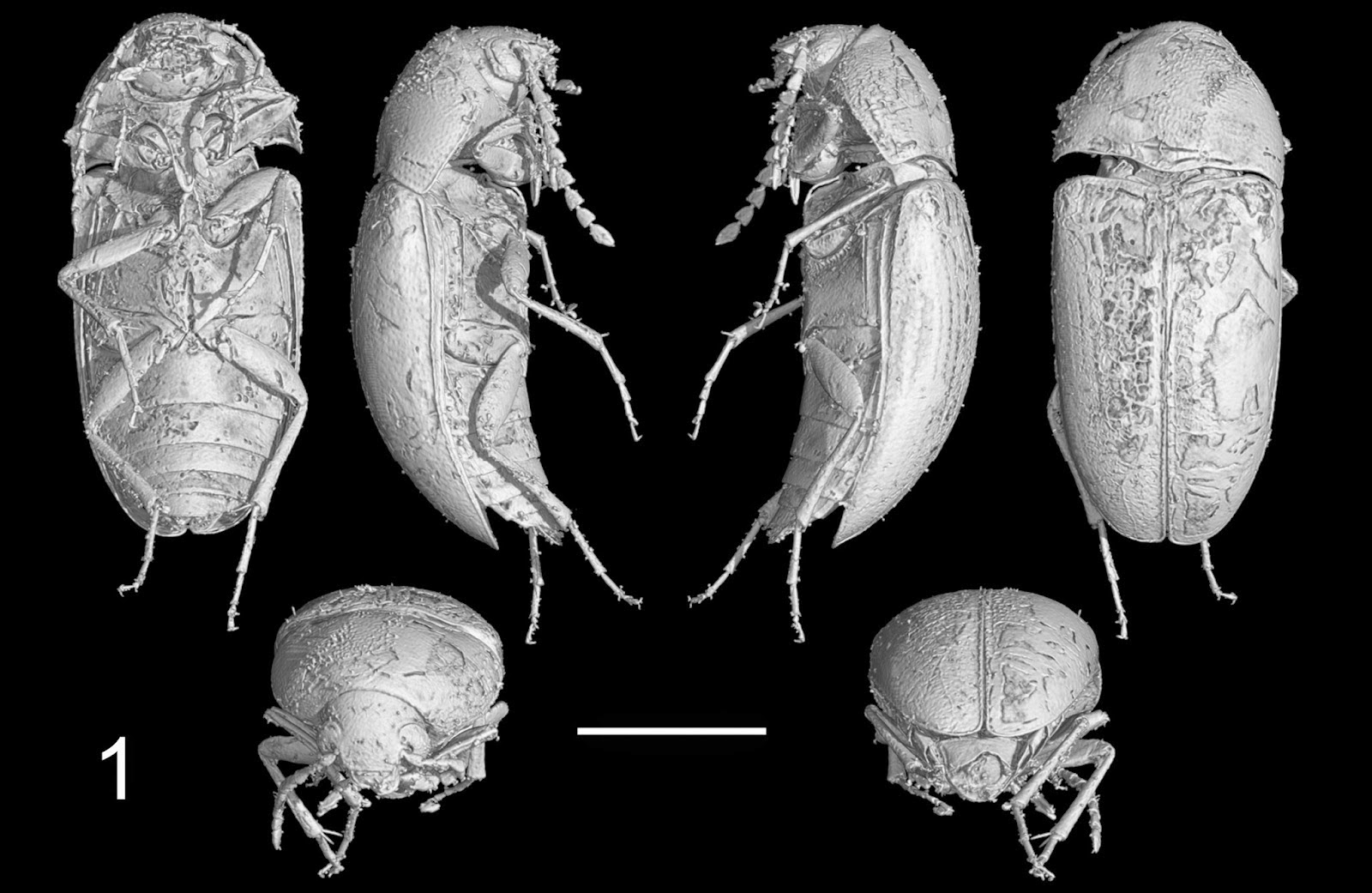Bess Beetles, Passalidae, are large (usually over 20 mm),
wood-feeding Beetles found predominantly in the tropics. They have a subsocial
lifestyle (unusual in Beetles), breeding in colonies in rotting logs, where the
adults care for the young, by processing food for them; the wood consumed the
adults is broken down by gut microbes, producing edible droppings consumed by
both adults and young. They are also capable of quite complex communication,
which adults of some species having been demonstrated to produce as many as
fourteen distinctive signals by rubbing their legs against their wing-cases.
In a paper published in the journal Zootaxa on 3 December 2014, EnioCano of the Museo de Zoología “Alfonso L. Herrera” and Departamento deBiología Evolutiva at the Universidad Nacional Autónoma de México, the Universidaddel Valle de Guatemala and the Museo de Historia Natural and Escuela de Biología
at the Universidad de San Carlos de Guatemala described nine new species of
Bess Beetles from Central America, all of which are placed in the flightless
genus Ogyges.
The first new species described is named Ogyges cavei, in honour of the entomologist Richard Cave for his
work in Central America. The species is described from two female specimens,
one collected from cloud forest between 1800 and 2100 m in the Olancho
Department of Honduras and the other collected from cloud forest at about 2000
m in the Comayagua Department, also of Honduras (the two locations being widely
separated. The first specimen is 40.48 mm in length and 14.41 mm wide, the
second specimen is 38.91 mm long and 13.64 mm wide. Both are a glossy black
colour, with distinct grooves on the wing-cases.
Ogygescavei, female specimen in lateral view. Cano (2014).
The second new species is named Ogyges handali,
in honour of Commander Schafik Handal for his efforts to bring peace in Central
America. The species is described from 49 specimens collected from fragments of
cloud forest in the Cerro Montecristo in Guatemala, between 1640 and 1900 m; it
is thought likely that this species will also be present in Honduras and El
Salvador. The specimens are 30.54–35.58 mm in length and 9.7–11.54 mm in width,
and black or reddish brown in colour.
Ogyges handali in lateral view. Cano (2014).
The third new species is named Ogyges laurae,
in honour of the myrmecologist (scientist who studies Ants) Laura Sáenz. The
species is described from eleven specimens collected in the Cerro La Picucha
cloud forest in the Olancho Department of Honduras, at altitudes of 1800-2100
m. These range from 18.71 to 22.91 mm in length and from 7.24 to 8.10 mm in
width and are light brown or black with a bluish iridescence (sheen) in colour.
Ogyges laurae in lateral view. Cano (2014).
The fourth new species
described is named Ogyges llama, in
honour of the Leaf Litter Arthropods of Mesoamerica (LLAMA) project at the NationalScience Foundation led by Jack Longino and Bob Anderson, which collected
several of the specimens used in this study. The species is described from 44
specimens collected in the Cerca de San Pedro Sula in the Cortés Department of
Honduras, at altitudes of about 1580 m. These specimens are 19.30 to 24.49 mm
in length and 7.55 to 8.69 mm in width and have a black upper surface with a
bluish iridescence and a dark brown lower surface.
Ogyges llama in lateral view. Cano (2014).
The fifth new species is named Ogyges menchuae,
in honour of Rigoberta Menchú Tum, who was born in Laj Chimel and who won the NobelPrize for Peace in 1992. The species is described from 35 specimens collected from
the Cerro El Amay cloud forrest of Laj Chimel in the Quiché Department of
Guatemala at altitudes of 1800to 2100 m. The specimens are 29.36 to 33.15 mm in
length and 10.12 to 11.72 mm in width and black in colour.
Ogyges menchuae in lateral view. Cano (2014).
The sixth new species described is named Ogyges mutenroshii, named in honour of the character Muten Roshi
(Master Roshi) from the manga and anime series ‘Dragon Ball’ by Akira Toriyama.
The species is described from two specimens of indeterminate sex collected from
cloud forest in the the Cerro Azul Meambar National Park in the Comayagua
Department of Honduras at altitudes of 1656 m and 1550 m. The specimens are
34.56 and 33.19 mm in length and 12.05 and 11.52 mm in width, and black in
colour.
Ogyges mutenroshii in lateral view. Cano (2014).
The seventh new species is named Ogyges ratcliffei,
in honour of the entomologist Brett Ratcliffe, the leader of Team Scarab, for
his work on Dynastine Beetles. The species is described from a single specimen
collected from cloud forest in the Reserva La Picucha in the Olancho Department
of Honduras, at an altitude of between 1800 and 2100 m. The specimen is female,
33.02 mm long and 11.95 mm wide and black with a blue iridescence.
Ogyges ratcliffei, female specimen in lateral view. Cano (2014).
The eighth new species described is named Ogyges sandinoi, in honour of Augusto César Sandino, a Nicaraguan
national hero who was born in the Segovia Mountains. The species is described
from five specimens collected from cloud forest at Cerro Jesus on the border
between Honduras and Nicaragua at an altitude of 1600 m. The specimens are 30.02–31.63
mm long and 10.23–11.19 mm wide, blackin colour, with some dark brown areas on
the underside.
Ogyges sandinoi, male specimen in lateral view. Cano (2014).
The final new species described is named Ogyges toriyamai, in honour of the Japanese artist Akira Toriyama,
creator of the manga and anime series ‘Dragon Ball’. The species is described
from four specimens collected from cloud forest in the Cerro Azul Meambar
National Park in the Comayagua Department of Honduras. The specimens are 28.29–31.06
mm long and 9.69–11.21 mm wide and black with a blue iridescence.
Ogyges toriyamai, male specimen in lateral view. Cano (2014).
See also…
Beetles first appear in the fossil record in the Early Permian. And
by the Triassic were already beginning to dominate Insect faunas, with many
modern groups in existence by the end of the Cretaceous. However...
 A new species of Scarab Beetle from the Elandsberg Mountains of the Western Cape, South Africa. Scarab Beetles of the genus Trichostetha occur across southern Africa, reaching their greatest diversity in...
A new species of Scarab Beetle from the Elandsberg Mountains of the Western Cape, South Africa. Scarab Beetles of the genus Trichostetha occur across southern Africa, reaching their greatest diversity in...
Follow Sciency Thoughts on Facebook.











